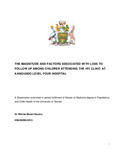| dc.description.abstract | Background: Over the past decade, significant gains have been made in enrolment
and care of HIV-infected children in Kenya. Their long-term survival depends on lifetime
adherence to antiretroviral therapy. African studies have reported high rates of Loss to
Follow up (LTFU) among children in HIV care and treatment centres. Factors
associated with LTFU may vary across populations and countries. Few studies have
been conducted among HIV infected children in care in rural areas of Kenya.
Objective: To evaluate the incidence and factors associated with loss to follow up in a
cohort of children aged less than 15 years attending the HIV clinic at Kangundo Level
Four Hospital.
Study design: We employed a multi-design approach in which we conducted i) A
retrospective cohort study to determine incidence and risk factors for LTFU through
abstraction of medical records and ii) A cross sectional survey in which we traced and
interviewed caregivers of children LTFU and conducted Focus Discussion Groups of the
healthcare workers to gain further insight into factors contributing to loss to follow up.
Methodology: We included all HIV-infected children aged below 15 years who were on
follow-up at the HIV clinic at Kangundo Level 4 Hospital between January 2010 and
December 2015. We obtained sociodemographic and clinical information from patient
files and electronic databases. Caregivers of children who had dropped out of care were
traced physically and interviewed using a questionnaire on the status of the child
(whether dead, alive), and the reasons for dropping out of care. We conducted focus
group discussions among the healthcare givers working in the HIV clinic to evaluate
health system factors associated with LTFU. Ethical approval was granted by Kenyatta
National Hospital/University of Nairobi Ethics and Review Committee. We calculated
period prevalence and incidence of LTFU over the 6 year period before and after
physical tracing of those LTFU. We performed logistic regression models to identify
factors strongly associated with LTFU. Qualitative data from focus group discussion was
transcribed and summarized into main themes manually.Results: Between January 2010 and December 2015, 261 HIV-infected children were
followed up at Kangundo Level 4 Hospital, with 51.3% being males. The mean age was
10.0 years (IQR 7-13), and median CD4 count of 582cells/ul (IQR 314-984). At the time
of enrolment into the study, 70 children (26.8%) were in HIV WHO stage I, 115 (44.1%)
were stage II, 61 (26.4%) were stage III and 2 children (0.8%) were WHO stage IV. The
overall follow up time of the whole cohort was 1003.9 person years with a median of 4
years (IQR1-5).
By December 2015, 171 children (65.5%) remained in active care, 32 (12.3%)
transferred out, 13 (5%) died, while 45 (17.2%) were classified as LTFU giving a period
prevalence of LTFU as 17.2% and incidence rate 44.9 (95% CI 43 to 47) per 1000 child
years.
Out of the 45 children presumed as LTFU, we successfully traced 44 out of the 45
children (98%),and found that their actual current status was as follows: 33 of the 44
children (75.0%) had dropped out of care, hence fulfilled the criteria for true LTFU, 6
children (13.6%) were dead and 5 (11.4%) had transferred themselves to other facilities.
The median time for those LTFU was 8 months (IQR 4-34) with a follow up time of 79.7
child years. Following tracing the true period prevalence and incidence of LTFU was
12.6% and 32.9 (95% CI 30.9 to 34.9) per 1000 child years respectively.
Factors strongly predictive of LTFU included male gender ( HR 1.22, 1.08-2.63,
p= 0.025) low caregiver level of education (HR 2.3, 1.9-3.9, P =0.001), WHO stage I
and II at enrolment (HR 1.6, 1.4-2.1, P =0.05) and children not on ART at last contact
with hospital (HR 4.7, 4.4-6.0, p=0.03). The factors perceived by healthcare workers to
contribute to loss to follow up included stigma, inadequate staffing, poor clinic physical
infrastructure and poor attitude of health care workers.
Conclusions: Over the 6 year period, LTFU of HIV infected children was common with
an incidence rate of 32.9 per 1000 child years and occurred early in treatment and risk
factors included low caregiver education, male child, early HIV disease stage and not
being on ART. | en_US |
| dc.description.department | a
Department of Psychiatry, University of Nairobi, ; bDepartment of Mental Health, School of Medicine,
Moi University, Eldoret, Kenya | |


